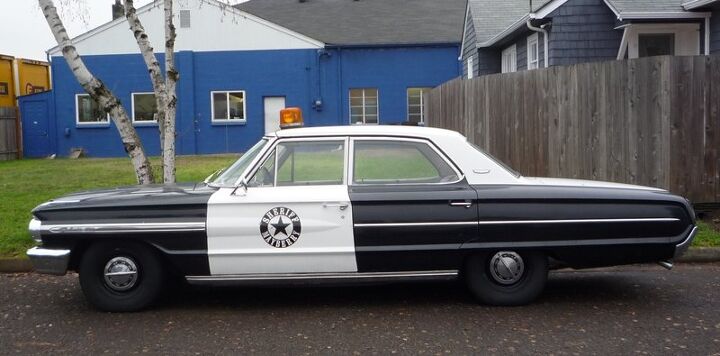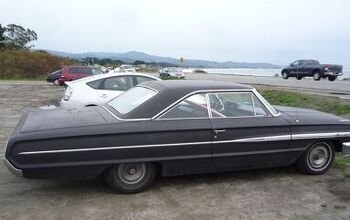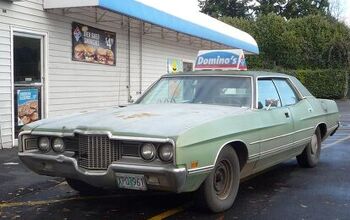Curbside Classic: 1964 Ford Galaxie 500 Police Interceptor

Finding Andy Griffith’s cop car on the streets of Eugene wasn’t exactly high on my predictability scale. But I’ve finally thrown that away, and nothing surprises me anymore. As far as I know, Deputy Barney Fife grew a ponytail, headed to Eugene and is using his old Mayberry cruiser in a ruse to keep the cops away from his grow operation. But there it sits, and it being Cop Car Friday, it’s now yours to ponder its existence on a side street off 1st Ave. But since its light isn’t flashing and might not hold your attention sufficiently, let’s also do a mini-history of the cop car.
What’s obvious is that this is a fake, since police departments didn’t spend their money on top-of-the line Galaxie 500 trim cars. They would have been riding in a stripper Ford Custom, if Ford was their choice of Cruiser, which was reasonably common enough. Well, actually, by the sixties, Dodges and Plymouths were taking a big chunk of the police car market, but Mayberry wasn’t exactly representative of the real world. And Ford obviously had a product placement deal with the producers of The Andy Griffith show.
I did a little I Tubing last night in hopes of some footage of the ’64 version of Sheriff Andy’s car, but no such luck. A brief glimpse of a ’63, and a ’65 was about it. But there is this short clip of a typical Barney Fife routine with a first year season ’60 Ford (the show ran from 1960-1968). ( You Tube, embedding disabled).
From old articles and such, it seems that Fords were particularly popular cop cars during the flat head V8 era of the thirties through the early fifties. The V8 was a tad more powerful than its competitors, although not nearly as much as legend might suggest. In fact the OHV Chevy six nipped at its heels most years, and some years like 1953, was rated higher than the Ford.
Allpar has an excellent article on the history of Chrysler Corp. police cars (naturally), which even claims that a test (slightly suspect) by the Greeley CO police department of 1935 Ford, Chevrolet and Plymouth models showed the flat head Plymouth six outrunning the competition by a healthy margin, with a top speed of ninety, compared to 82 for the Ford and 78 for the Chevy. Ringer?
In 1949, the new Ford offered overdrive, which combined with the 100hp V8 made it the fastest of the low-cost Big Three. But Mercuries with the bigger flathead were also popular, and big cars like the eight cylinder Chryslers were not uncommon.
That Allpar article also points out that most early cop cars were of the business coupe variety, lacking a back seat. Perhaps their large trunks made a safe way to haul a suspect to jail. And it wasn’t until 1956 that Chrysler began to advertise its police and taxi fleet cars, and offer the first official police package. Detroit’s horsepower war of the late fifties played right into the growing market for police cars, and bragging rights to the fastest police cars became the flip side to the muscle car era of the times.
The police car business became increasingly competitive, and I remember vividly the accusations of bribes when Baltimore County switched from decades of Fords to Chevys in 1968. Well, corruption was rampant there anyway, but the ’68 Chevy was might appealing, with its 396 engine and slotted rally wheels through which to admire the new disc brakes. The Ford FE 390 couldn’t touch the new Rat Motor, as if it really mattered anyway, in Balto Co.
But there’s no doubt that Chrysler engineering was particularly appealing to hard core police work. In the pre-disc brake era, Chrysler offered big 12″ drums that were as good as it got. Here’s an excerpt from that article about a cop stopping a runaway tractor-trailer truck:
A Nevada Highway State Trooper, while patrolling in the mountains near Sparks in his 1957 Plymouth, spotted a tractor-trailer going down the mountain. The driver signaled wildly that the air brakes had gone out. The Trooper wheeled around in a “bootlegger’s turn” at 40 miles an hour. He then accelerated to over 120 mph to catch the run away truck. Momentarily blocked by on coming traffic, the Trooper had to stay in line behind the free wheeling 18 wheeled monster. He clocked it at 85 mph, as it was accelerating climbing towards 90. As soon as he got clear, the Trooper accelerated past the roaring 60 tons of rolling menace. Once in front of the tractor, he backed off the throttle, slowly allowed the tractor’s front bumper to contact the rear of the Plymouth. Using his service brakes, the Trooper steadily pumped the brake pedal, keeping the front bumper of the truck against his car. At first, it didn’t seem to have much affect. However, with smoke coming from all four of the Plymouth’s service brakes, the speed began to steadily decrease. Slowly, then more rapid. 80…75…65…60…50…then 40…30…and finally down to 20 miles per hour where the tractor driver was able to stop by using his transmission downshifting, and the soft edge of the road. It was a good thing because the Plymouth had precious little left to give. As the Trooper stopped the two front tires explosively blew out from the tremendous heat. The fins and truck area were bashed in, as well as pushed downwards from the force of the weight of the truck. However, Once again, MoPar engineering had saved lives! Had that truck entered the small town at the base of the mountain, who knows how many could have been injured or killed.
It might also be relevant to know that hardly all police cars were the high performance versions. Chrysler offered three distinct levels: the six cylinder “Sentinel” for economical city operations; the “Metro Patroller” with a mid-level V8; and the “Pursuit Special” with the highest output big-block V8. A 1964 Dodge Polara with the 413 wedge had a top speed of 129 mph.
But the real golden era for high speed cop cars were the 440 powered Dodges and Plymouths, as favored by the CHP. A 375 hp special-cam 440 in a 1969 Polara sedan held the record for fastest police car, timed at 149.6 mph at the Chelsea test track. That would not be bettered for twenty five years, when an LT-1 powered 1994 Caprice finally took the crown away.
But the years in between those two were a deep valley. Smog controls and CAFE regs utterly destroyed cop car performance in the seventies. The absolute nadir was in 1980 and 1981, when the Dodge St. Regis police cars came with no more than a 318 rated at 165 hp. According to the allpar article, this sad “police pursuit” topped out in CHP testing at 105 mph without the light bar. Since I was an inveterate speeder in CA during that time, I know as a matter of fact that these Dodges petered out at about 90-95 with the light bars installed (and flashing). Don’t ask.
It was a major embarrassment for the CHP when this became public knowledge in California, especially since radar was banned at the time. If the CHP couldn’t keep up behind you to pace you properly… Anyway, there was a good reason the CHP grabbed the first batch of new Mustang GT coupes available for pursuit work as soon as they became available in about 1983 or 1984. Yes, it all seems like a distant dream now, when speeding was still a fun cat and mouse game, with a level playing field. Or unlevel, in the case of the St. Regis.
We haven’t talked much about this Ford car, but if it had been a top-line pursuit car, a 390 would have been under the hood, since the 427 was not police-friendly, and the 428 was still a few years away. That alone helps explain Chrysler’s popularity with the police departments during this era. But it’s probably just as well that any seriously fast cars were kept well away from Barney Fife.

More by Paul Niedermeyer
Latest Car Reviews
Read moreLatest Product Reviews
Read moreRecent Comments
- Slavuta I drove it but previous style. Its big, with numb steering feel, and transmission that takes away from whatever the engine has.
- Wjtinfwb Rivaled only by the Prowler and Thunderbird as retro vehicles that missed the mark... by a mile.
- Wjtinfwb Tennessee is a Right to Work state. The UAW will have a bit less leverage there than in Michigan, which repealed R t W a couple years ago. And how much leverage will the UAW really have in Chattanooga. That plant builds ID. 4 and Atlas, neither of which are setting the world afire, sales wise. I'd have thought VW would have learned the UAW plays by different rules than the placid German unions from the Westmoreland PA debacle. But history has shown VW to be exceptionally slow learners. Watching with interest.
- Ravenuer Haven't seen one of these in years! Forgot they existed.
- Pig_Iron I one of those weirdos who liked these.








































Comments
Join the conversation
This would be more accurately billed a replica of a Mayberry Police car, and not an actual police car. The police cars used in the Andy Griffith show were never real police cars. They were cars supplied by the local Ford dealer, painted as a cop car, and when they switched it out, they painted it back to the normal color and sold it as a used car. To my knowledge, there was never a 1964 used in the show. It skipped from 63-65, but a 64 is a great tribute either way. Great job to whomever did this or owns it.
Hey All, Permit me to introduce myself. I am JCAllison, 75, caretaker of "Ms. American 3.14159" who happens to be the ONLY 1964 Ford Galaxie 500, Four-Door, Hard-Top, Fast Back, Police Interceptor that Google finds on the whole World Wide Web. Ms. American 3.14159 was built for the Chief of Police of Fontana, California in March of 1964. What the Chief thought he was going to get was a 54B Bodied (Ford Custom 500, 4-Door Sedan), Model 52 (4-Door Sedan), with a P-Code Police Interceptor Engine, 390 CID, 330 HP, with Solid Lifters, Cast Iron Shorty Headers, Borg Warner T85 Three Speed Overdrive Transmission, a 4.11:1 Differential, and five Kelsey Hayes 15" Severe Service Wheels. This is commonly known as a "Mayberry Special" made famous by the Andy Griffith Show. BUT, whomever wrote the order, or whomever read the order at the Los Angeles Ford Factory built a 57B Bodied (Galaxie 500, 4-Door Fastback) Model 64 (4-Door Hardtop) with a P-Code Police Interceptor Engine, 390 CID, 330 HP, with Solid Lifters, Cast Iron Shorty Headers, Borg Warner T85 Three Speed Overdrive Transmission, a 4.11:1 Differential, and five Kelsey Hayes 15" Severe Service Wheels. The vehicle arrived at the Fontana Motors Ford Dealership and the Mayor and City Council of Fontana decided that because it was a "luxury" body style that they would not permit the Chief to take possession of it. My father happened to be there when all this happened, and was ready to buy a NEW Ford. The Fontana government and law enforcement personnel went off to discuss the matter, and Fontana Motors, not wanting to be involved in a dispute with the Fontana officials were more than happy to get rid of the vehicle ASAP and so it was that they sold it to my father for cash at their cost of $2,671.00. It became my mother's daily driver. In June of 1986, she could no longer see well enough to pass her driver's test, and told my father that she would drive without a license. In order to keep THAT from happening, my father called me and said: "You've always liked this old Ford, if you want it, I'll sell it to you for a buck!" I flew from Houston Hobby Airport to Ontario International on Friday evening after work, was picked up there late Friday night by my father, driven back to my parent's place in Cherry Valley, California where I spent the night, leaving for Houston early Saturday morning. Ms. American 3.14159 and I arrived back in Houston in time for me to go to work on Monday morning, and Ms. American and I have been together ever since. She is presently awaiting a complete front suspension rebuild. Ms. American's P-Code Engine was rebuilt in 1989, At that time she had 167,310 miles on her Odometer. She was fitted with a Crane 97 Fireball Cam, a Holly 650 CFM 4160 Carburetor w/ Vacuum Secondaries, a Hayes Clutch, and a Mallory Ignition Coil. She has since be refitted with the original 600 CFM Autolite 4100 C4AF9510-DG Carburetor. She is now just 1,271 miles away from having 300,000 miles on her odometer. She is up on jack stands and gets started once a month, brought up to operating temperature, run through the gears a number of times and then covered back up with plastic sheeting held down by a large tarp. She is a wonderful old Gal, world famous by dint of being well know on most of the Ford Auto Forums, especially the FordMuscle Galaxie Forum where much of the work that has been done on her has been documented, accompanied by copious JPGS. As a side note, Ms. American 3.14159 has a running mate whose name is Lorrie Van Haul, a Right Hand Steering 1967 Dodge P200 Postal Van with a 225 Slant Six Engine, an A727 Torqueflite Automatic Transmission, a 9.5" 4.55:1 SureGrip Rear Axle, a Mopar Electronic Distributor, a Standard Bluestreak Electronic Control Module, a Ford HEI Ignition Coil, with NGK ZFR5N Spark Plugs, gapped to .045", a Bendix Stromberg Model W Single Venturi Carburetor, a complete set of Stewart Warner 2-5/8" Gauges, and a Suburu Reclining Seat. There were 3,500 of these P200 3/4 ton Postal Vans built, and as far as can be determined, Lorrie Van Haul is the only one still on the road. Lorrie was bought from the Houston United States Postal Service in 1975 for $750.00, and is likewise world famous by dint of being on most of the Dodge Auto Forums, especially the DodgeTalk Forum where her complete four year rebuild starting in 2008 was documented. Anyway, TTAC was found when I did a search about 1964 Ford Police Interceptors and found this thread. Though that you all might be interested in knowing that there is at least one 1964 Ford Galaxie 500, Four-Door, Hard-Top, Fast-Back, Police Interceptor in the world. She is a wonderful example of a time when cars were produced without a built in obsolescence factor, made of REAL metal, and thatcan actually be worked on and kept running using only hand tools and not needing a bunch of computer diagnostic equipment. :) Hope this finds you all doing well and hanging in there. Take excellent care. JC